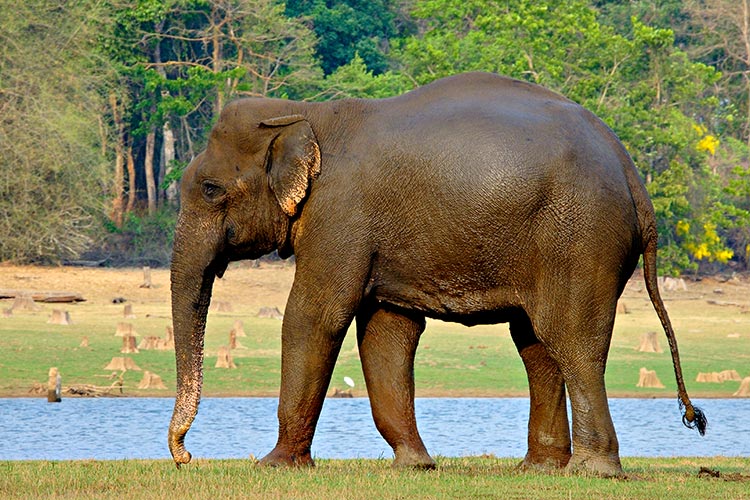Travelling by bus from Bengaluru for a trip to Nagarhole National Park, we stopped at the forest check post as we reached the Park, where the driver and the forest guard exchanged greetings. The driver cautiously asked if elephants had been sighted on the main road that day. His tension eased visibly when he received an answer in the negative. Majestic teak trees towered over us, and I became aware that but for the racket the bus was making, the forest was silent. The silence was broken every now and then by the raucous calling of a peacock, or by the cackle of the jungle fowl. After freshening up in the basic but clean Forest Department rest house, I opted for a jeep ride around the forest. There’s a well-defined network of roads in the forest, good for the tourist, but possibly disturbing for the animals. The Department maintains ‘view-lines’, 10 m long areas on both sides of the roads, where shrubbery and trees are cleared for an unbridled view of the wildlife. These spots, usually created by burning the plants, also attract animals — fresh grass sprouts in these areas, functioning as magnets for fauna. It helps that the terrain in Nagarhole is mostly flat; visibility is high. I spotted a few herds of cheetal and troops of langurs as soon as we started the drive. As we drove along the winding forest roads, our group encountered a large herd of gaur grazing and browsing in an opening near a ‘view-line’.
Leopards Ahoy!
As we turned around a sharp curve, we heard a faint sawing noise — a mixture of a rasp and a cough, the distinct call of the leopard. Immediately, we heard the alarm calls of langurs. Holding our collective breaths and cameras, we waited. Soon enough, a leopard and two cubs emerged onto the road. The leopard saw us, and sauntered indignantly across the road into the jungle. The cubs lingered, curious. But they too scampered across, anxious to stay close to their mother. On the way back, we saw a herd of elephants grazing. As the light was rapidly diminishing, our driver was not happy to see them — elephants have poor eyesight, and are known to charge at vehicles. These, however, were uninterested in us. Back in the camp, after a hot bath, I enjoyed a simple, sumptuous meal and saw some wildlife videos at the camp’s Wildlife Interpretation Centre.
Enter the King
The next morning, we left the camp at daybreak, with hope written large on our faces. It was a beautiful misty morning. We saw a herd of sambar, browsing cautiously by the side of the road. All of a sudden, they would look around frantically, and then return to their meal. Nearby, we heard the screech of the crested serpent eagle. Looking closer, I saw that it held a small snake in its claws. It was breakfast time at Nagarhole National Park! We slowed down as we approached a waterhole: this spot was supposed to be a favourite with tigers. While waiting, I spoke to our driver Bomma, and asked him whether he had seen any tigers this month. After thinking for not less than five minutes, he told me that he had seen them everyday, except for the previous Saturday and Sunday! Bomma became impatient after waiting for sometime, and suggested that we head elsewhere. I was visiting in October, and there was plenty of water everywhere. The chances of seeing a tiger at a waterhole are higher in summer. The sun’s rays became stronger, and the birds more active. Woodpeckers, drongos, tree-pies and orioles were flying past in an amazing riot of colour. Suddenly, the forest became silent, and we heard the cries of a sambar. After that alarm call, other animals also started theirs — there was the whoop-whoop of the langur and the high-pitched call of the cheetal, among others. We waited with bated breath, and suddenly saw the huge head of a tiger peeping out of thick lantana bushes. People have often commented on how larger than life the tiger actually looks. It is a big cat, but one realises how big only after sighting one. It gazed at us for a while, and then emitted a low snarl as it crossed the road, and disappeared from our sight.
The Park
One of the oldest National Parks in India, Nagarhole (‘Serpent River’) was once maintained as a hunting preserve for the Mysore royal family. The NP was created in 1955. The Forest Department constructed rest houses and other facilities in the Park. Its limits were increased to its present-day area of 645 sq km in 1974. It was renamed after Rajiv Gandhi in 1992.
Location
Spread over Mysore and Kodagu districts, Nagarhole NP is bounded by the Kabini River to the south, the Wayanad WLS to its south-west and the Bandipur Tiger Reserve to its south-east.
Distances
95 km SW of Mysore, 222 km SW of Bengaluru.
Route from Bengaluru
SH17 to Srirangapatna via Maddur; bypass to Coorg via Ranganathittu; SH88 to Hunsur; state roads to Nagarhole via Veeranahosahalli and Murkal.
When to go
The best period to visit is October-March.
Park closes sometimes, for safaris, in March-April.
Go there for Elephants, tigers, leopards, dhole, gaur, sambar.
Wildlife/ Forest Dept offices
Conservator of Forests and Director, Nagarhole Tiger Reserve Hunsur. Tel: +91-822-2252041. Field Director Project Tiger, Aranya Bhavan, Ashokapuram, Mysore Tel: +91-821-2480901-02 STD codes Hunsur 08222, Nagarhole 08228.
By Kshitiz






